
Rosaceae, the rose family, is a medium-sized family of flowering plants that includes 4,828 known species in 91 genera.

Filipendula ulmaria, commonly known as meadowsweet or mead wort, is a perennial herbaceous plant in the family Rosaceae that grows in damp meadows. It is native throughout most of Europe and Western Asia. It has been introduced and naturalised in North America.
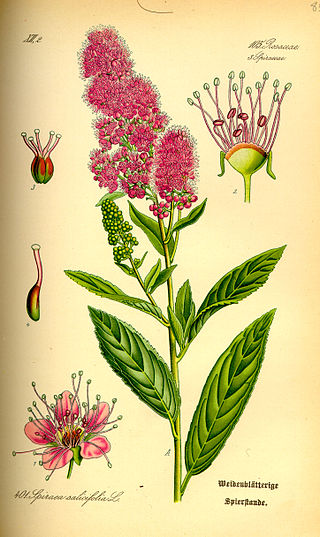
Spiraea, sometimes spelled spirea in common names, and commonly known as meadowsweets or steeplebushes, is a genus of about 80 to 100 species of shrubs in the family Rosaceae. They are native to the temperate Northern Hemisphere, with the greatest diversity in eastern Asia.

Filipendula is a genus of 12 species of perennial herbaceous flowering plants in the family Rosaceae, native to the temperate regions of the Northern Hemisphere. Well-known species include meadowsweet and dropwort, both native to Europe, and queen-of-the-forest and queen-of-the-prairie, native to North America.

Spiraea splendens is a shrub of the rose family (Rosaceae) native to the western mountains of North America, from California to British Columbia, commonly known as dense-flowered spiraea, rose meadowsweet, rosy spiraea, subalpine spiraea, and mountain spiraea. It is commonly found at elevations between 2,000 feet (610 m) and 11,000 feet (3,400 m) on inland mountain ranges. The plant is adapted to cold, moist, rocky slopes, subalpine forests and meadows.

Spiraea japonica, the Japanese meadowsweet or Japanese spiraea, is a plant in the family Rosaceae.
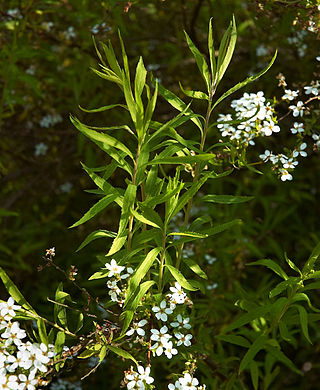
Spiraea thunbergii (珍珠绣线菊), Thunberg spiraea or Thunberg's meadowsweet, is a species of flowering plant in the rose family, native to East China and Japan, and widely cultivated elsewhere.
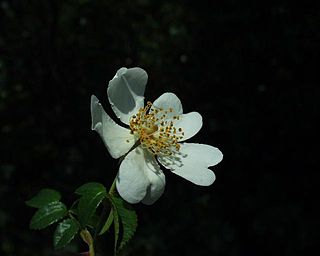
Rosa sempervirens, the evergreen rose, is a species of wild rose native to the Mediterranean. It is a climbing perennial with very prickly stems.

Rosa majalis is a species of deciduous shrubs in the genus Rosa, native to forests of Europe and Siberia. It grows to 2 m. and yields edible hip fruits rich in vitamin C, which are used in medicine and to produce rose hip syrup.
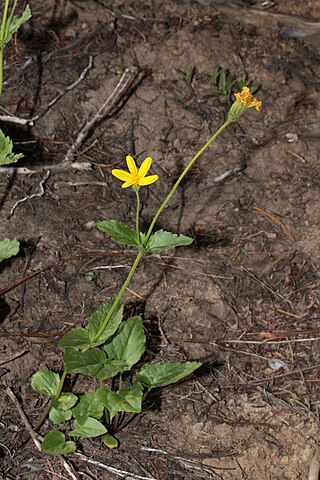
Arnica latifolia is a species of arnica in the sunflower family, known by the common names broadleaf arnica, broad leaved arnica, mountain arnica, and daffodil leopardbane. It is native to western North America from Alaska east to Northwest Territories and south to Mono County, California, and Taos County, New Mexico. It grows in mountain habitat such as forest and meadows.
Meadowsweet may refer to:
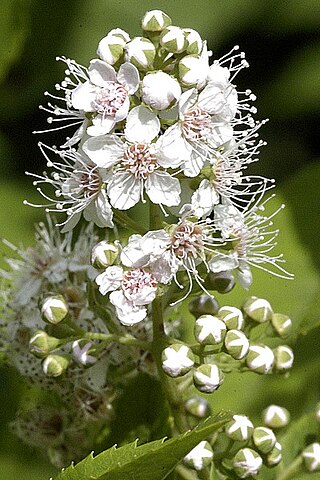
Spiraea alba, commonly known as meadowsweet, white meadowsweet, narrowleaf meadowsweet, pale bridewort, or pipestem, is native to the wet soils of the Allegheny Mountains and other portions of eastern North America, but is currently endangered in the state of Missouri. It is naturalized in other parts of the world.

Spiraea virginiana is a rare species of flowering plant in the rose family (Rosaceae) known by the common names Virginia meadowsweet and Virginia spiraea. It is native to the southern Appalachian Mountains, where it has a distribution scattered across nine states. However, most populations are very small and poor in quality. It is threatened by disturbances in the hydrology of its habitat, introduced species of plants, and other threats. It is a federally listed threatened species of the United States.

Turgenia is a genus of flowering plants in the family Apiaceae, containing up to seven species. The genus resembles Caucalis. False carrot is a common name for plants in this genus.

Spiraea chamaedryfolia, common name germander meadowsweet or elm-leaved spirea, is a species of plant belonging to the family Rosaceae.

Hemileuca lucina, the New England buck moth, is a species of moth in the family Saturniidae. This moth species is only found in the New England region of the United States. Larvae in early stages mainly feed on broadleaf meadowsweet whereas larvae in later stages show variation in food sources such as blackberry and black cherry leaves. Larvae have a black body with orange/black spines on their back that are used to deter predators. Pupation occurs during the summer and adult moths come out around September.

Rosa tomentosa, otherwise known as the harsh downy-rose, is a species of wild rose. It is a shrub growing to about 3 metres (10 ft). It is found in Asia Minor, the Caucasus, and much of Europe: the British Isles, France, Central Europe, northern Spain, Italy, and the Balkans . On the British Isles it can be found in hedgerows and woodland margins, and it typically flowers between June and July. Further south, in Bulgaria, it flowers in May.

Spiraea trilobata, known as Asian meadowsweet, is a species of flowering plant in the family Rosaceae. It was first formally named in 1771. Spiraea trilobata is native to Asia. It has occasionally naturalized in the United States.

Spiraea salicifolia, the bridewort, willow-leaved meadowsweet, spice hardhack, or Aaron's beard, is a species of flowering plant in the family Rosaceae. A shrub, it is native to east-central Europe, Kazakhstan, all of Siberia, the Russian Far East, Mongolia, northern China, Korea, and Japan, and it has been widely introduced to the rest of Europe and to eastern North America. It has been cultivated since the 1500s for hedges and similar applications, but is not particularly well-behaved.
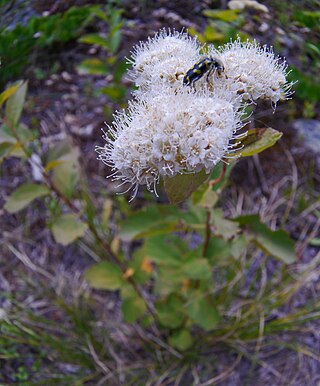
Spiraea lucida, the shiny-leaf meadowsweet, is a species of flowering plant in the family Rosaceae, native to western Canada as far as Saskatchewan, and the northwestern United States as far as the Dakotas. In the past, due to its leaf morphology varying greatly because of the plants' tendency to die back to the ground in winter, it was considered a variety of Spiraea betulifolia, the white or birch-leaf meadowsweet.



















